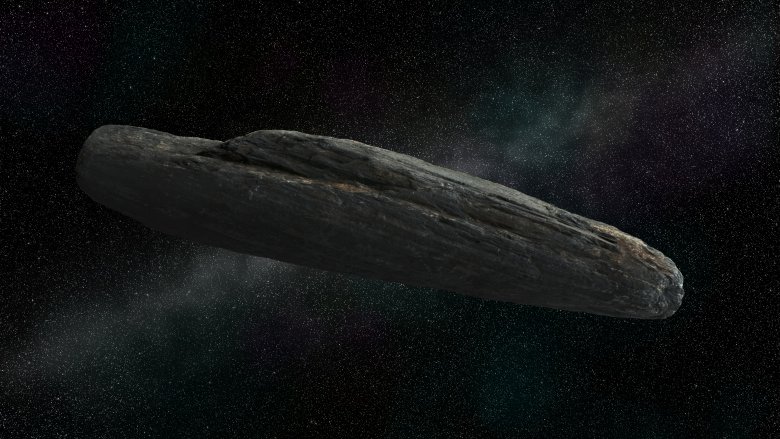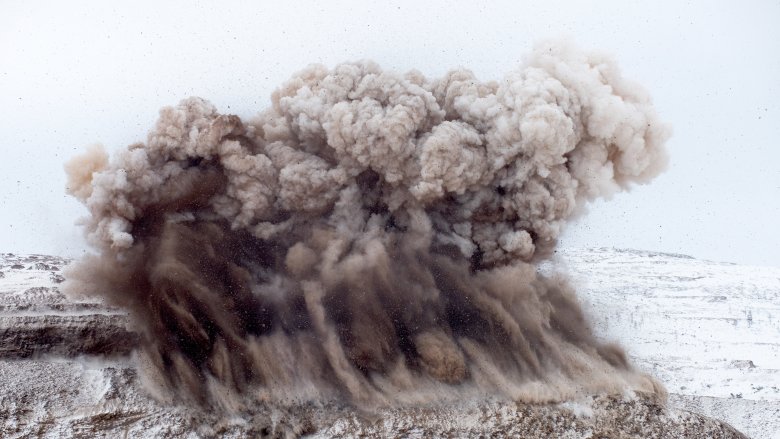Unexplainable Things That Happened In 2017
We can probably all admit that science is pretty good. It gave us helpful things like cars and the polio vaccine and Pop Rocks. It has helped us understand concepts like bacteria, and quantum uncertainty, and why apples keep falling on our powdered-wigged heads. Theoretically, given enough time and data, science would be able to explain anything because it is assumed that the known universe plays by an unbreakable set of rules that we can use to predict behavior and events.
However, while science can presumably ultimately explain everything, there are a few things that science — or more accurately, scientists — can't explain ... yet. It's not that these things will never be able to be explained, simply that there is not enough data to explain them now. Strange sounds, mystery holes, living specimens of long extinct species, ghost selfies: You name it, a year is enough time for any number of strange events to unfold. Here are a few of the most inexplicable events of the year 2017.
Giant radioactive cloud over Europe
Live Science reports that in early October 2017 a huge cloud of radioactive material innocently floated over 14 European countries, a totally normal thing to have happened. You may consider that maybe it was just a totally normal glow cloud such as might rain dead animals on the ice cream shop. It turns out, however, that rather than being filled with crows and armadillos, it was actually packed to the gills with ruthenium-106, which sounds so scientific that it would be almost impossible to discern if that was good or bad.
Well, no, okay, actually scientists do know and it turns out that it's bad. High amounts of ruthenium-106, if ingested, can be toxic and carcinogenic. Is this enormous Europe-sized cloud a high amount? The Russian Meteorological Service said that in September it detected ruthenium-106 levels in the Ural Mountains, the main source of ruthenium in the region, that were 986 times above normal, which seems, uh, fine. The IRSN, an organization whose name is four French words telling you that they know when things are way too nuclear, says that, no, actually, this is fine.
While we don't know the exact source of the radioactive not-death cloud, we do know that it definitely came from Russia and that ruthenium-106 does not occur naturally, but rather typically from nuclear waste. However, Russian officials, a historically trustworthy and forthright bunch, have denied any kind of nuclear accident. The science actually also backs this up, however. For now, this glow cloud is still a mystery.
A space rock that might be more than a space rock
As reported in The Atlantic, this October saw the first ever interstellar object — i.e., an object from outside our solar system — witnessed to pass through our solar system. This is pretty cool and a pretty big deal. The object has been named 'Oumuamua, which is Hawaiian for "messenger" or "scout," which is intended to refer to the fact that it's the first object from another star to make its way to us. But, as you can imagine, some people think the name is even more apropos: Yes, of course, they're thinking aliens.
This isn't just straight-up wackadoo thinking, however. Well, not entirely. The funny thing about 'Oumuamua is that it's not the shape you'd expect a fast-moving space rock to be. Generally, such things are roughly spherical, or at least potato-shaped like the asteroids in our solar system. 'Oumuamua, however, is long and thin, like a cigar or a needle. Also, it shows no evidence of having had a coma, which is to say the tail that comets have and not the soap opera plot device. The lack of water ice on it suggests that it is made of rock or — wait for it — metal.
So what is this cigar-shaped metal object hurtling through our solar system? Could it be a ship? No signs of life like radio signals or irregular flight paths as of this writing, but the fact is that we just don't have all the data about this mystery space cigar just yet. Fingers crossed for aliens.
16 people got sick at the Cuban embassy and maybe a secret sonic ray did it
Oh boy, who's ready for some James Bond business? Intrigue! Secret weapons! Sonic ray guns! International diplomacy! Tinnitus! Pew pew pew!
Between fall 2016 and spring 2017, 16 different people working in or near the U.S. embassy in Havana started suffering unexplained health problems, The Guardian reports. Officials said the diplomats and other employees removed from the embassy were experiencing a number of unspecified symptoms (this almost certainly means that uncontrolled pooping is one of the symptoms, but that's just a hopeful guess), but the one mentioned specifically by name was unexplained hearing loss. This hearing loss was so severe and strange that many of the employees were allowed to leave Cuba for the U.S. (If Michael Moore is to be believed, though, it might have been the better play to stay in Cuba to see a doctor. That's an aside. Back to sonic rays.)
Anyway, as you might imagine, Cuba has a pretty significant "state security apparatus" that monitors things pretty closely, and as you might imagine U.S. diplomats get an extra close eye. As such, officials suspect that this suspicious wave of hearing loss was probably caused by a secret sonic device implanted in the embassy. However, no device or perpetrator has been found just yet, so the cause is still a mystery. This is just an amateur suggestion, but maybe they should start looking for the guy with the facial scar and sinister monocle who's stroking a white cat?
Mystery booms in Arizona
It might be tempting to assume that not much of interest happens in Arizona. Despite its far-famed natural beauty and the fact that it's the only state with a capital whose name is also a Dungeons and Dragons monster (unless of course you rolled up an orc named Pierre or Jefferson City or something), Arizona is like 90 percent desert (don't check this math), so it would be easy to assume not much more happens than a Gila monster looking at a cactus or whatever.
But on November 27 and 28, it became host to a mystery: giant bone-rattling explosions of no known origin. According to Tucson News Now, these booms were heard across the southern regions of the state and were not only loud enough to shake windows, they actually registered on the seismic monitoring equipment at the University of Arizona Geosciences Department, who ruled out an earthquake. Local military bases deny running any operations including sonic booms or detonations, and the hours seem unusual for mining activity. One Air Force base was holding training exercises during that time period but could not conclusively say they were responsible for any mystery booms.
But if mystery sounds described as "like someone throwing boulders in a huge dumpster" aren't enough to interest you in the Grand Canyon State, how about this story about a college kid trying to solicit a companion with Sprite and chicken Alfredo? Admit it: If those stories turned out to be connected, you would move to Arizona tomorrow.
Mystery booms in New Jersey and also basically everywhere else
If loud, mysterious booms in Arizona aren't enough to intrigue or concern you, how about mysterious booms and rumblings in New Jersey? NJ.com reported a rumbling across South Jersey on October 25 that many assumed was an earthquake. However, investigations basically ruled out earthquakes, sonic booms, meteorites, or thunderstorms as possible causes. So, like, that seems normal, right? Was it just the Earth trying to reject New Jersey like a transplanted liver?
As likely as that last theory seems, that doesn't explain the similar mystery sounds in Arizona a month later. The obvious assumption is that these two mysteries are unconnected and there were just two different mystery boom-booms within a few weeks of each other. But there weren't just two. There have been a series of loud, unexplained booms across Alabama popularly known as "Bama booms." Further booms are recorded by Newsweek in Idaho, California, and Michigan. A similar boom in Colorado turned out to be an empty oil storage tank blowing its lid off, but that explanation won't play for all these other states. And it's not just the U.S. Wales had a bad case of the mystery sounds, too.
Anyway, this all seems pretty normal, right? Pretty normal for mystery explosions to just be happening across a country in the span of a few weeks, right? Definitely a cool thing we should definitely not be worried about, right?
A ghostly photobomb
In this age of ubiquitous phone cameras, photobombs have come to be an expected casualty. If you take enough selfies, just through sheer volume it's going to happen to you. If you gave a thousand monkeys a thousand selfie sticks, given enough time, one would definitely take a picture of itself with a guy in a backward ball cap and cargo shorts doing something rude in the background. In most cases, photobombs are performed by mischievous friends, drunken randos, drunken friends, mischievous randos, and sometimes like a turtle or something.
But in March, a teen girl in Tifton, Georgia, took a selfie with what appears, to these trained eyes, to be the ghost of someone's peepaw. As USA Today explained, 13-year-old Haley was on a fishing trip with her brother Kolton when she decided to take a selfie in the back seat of the car. When she looked back through her photos later, she saw, as expected, her brother, but next to him is the ethereal figure of a man in a ball cap and collared shirt who also appears to be in black and white, conclusively proving he's from a bygone era. Haley's mother assured her friends via Facebook that this black-and-white-tinted see-through gentleman had not, in fact, accompanied them on this trip.
Is it a hoax? Is it a trick of the camera? Did they lie about going fishing with a translucent man? Or could it be that even an undead peepaw can't resist a good photobomb?
Giant mystery hole in Antarctica
When you hear news these days of holes in polar ice, it's very easy to reply, "Well, yeah. Climate change is messing everything up. I'm surprised the ice in my freezer is still frozen, to be honest." And that's fair! But in the case of an enormous hole that opened up in Antarctica in 2017, it seems that climate change may not be the cause of literally only this one thing.
According to Business Insider, a hole opened in the sea ice of the normally frozen Weddell Sea in Antarctica. Big open areas in otherwise frozen seawater are not uncommon and are called polynyas. But this new polynya has scientists scratching their heads for a few reasons: For one, polynyas are normally near the edges of sea ice and this one is far from the ice coastline. Secondly, it has stayed open despite being exposed to freezing winds for over a month. Thirdly, and admittedly this is burying the lead, it's over 30,000 square miles in area, which is to say, about the size of South Carolina.
Even stranger, perhaps, is the fact that this isn't the first time this particular polynya has opened up. In the 1970s there was a hole in basically the same spot that was even bigger, about the size of Arizona. Then it reappeared in 2016, though much smaller than the '70s version. And now it's back.
Long-extinct Tasmanian tiger (maybe) caught on film
Cryptid hunting has enjoyed something of a boom in the last decade, with shows like Finding Bigfoot giving a platform to those who want to prove the existence of a missing link between humans and animals, or, you know, just enjoy straight up 'squatching it in the woods for money. These people and their ilk devote their time, resources, and money to trying to find a creature that most evidence seems to point at being a hoaxster in a Harambe suit.
The hunt for the thylacine, however, is a little different. The thylacine was a carnivorous marsupial also known as the Tasmanian tiger due to the striped pattern on its lower back. As the name suggests, it lived on the island of Tasmania, but the last known thylacine died in captivity in the 1930s. Or did it...? Probably, yes. But did it though?
Many have claimed over the years that the thylacine can still be found in the woods of Tasmania, but few offered any proof. However, as the Mercury reports, a team of whatever the Tasmanian equivalent of 'squatchers is has caught rare footage of what appears to be an actually alive and not that extinct thylacine and cub. An expert in Tasmania wildlife reviewed the somewhat grainy and distant footage and rated it as "perhaps a one in three chance" that the footage actually proves the Tasmanian tiger still exists. That may sound low, but you have to admit, it's better than 'squatch odds.
The universe existed
One of the strangest things that happened in 2017 is that there was a 2017. Or that there was literally any year before that. There shouldn't have been any years. There shouldn't have been any anything, ever. At least that's what we learned in 2017.
The question ultimately at the heart of almost any religion or philosophy is "Why is there something instead of nothing?" This year, as LiveScience reports, scientists just kind of shrugged and said, "Yeah, man, we don't know either. Literally nothing should exist." As you probably know, everything you interact with on a daily basis is made of matter: cats, marshmallows, your butt, cats' butts, etc. As you may also know, there also exists antimatter that annihilates matter upon contact, like adding 1 to -1. Well, it turns out that an equal amount of matter and antimatter was created at the instant of the Big Bang, and so all that stuff and antistuff should have balanced out, leaving us with literally nothing.
But as you sit there scratching your chin about the prospect of this, the fact that you have a chin to scratch should point out the flaw in this logic here. You might come in contact with as many as, say, 11 cats' butts on a daily basis but almost certainly zero anticats' antibutts. Either existence itself is a mystery so big that it can even make both STEM and the humanities admit that they're stumped, or else someone at CERN hecked up some math pretty bad.








